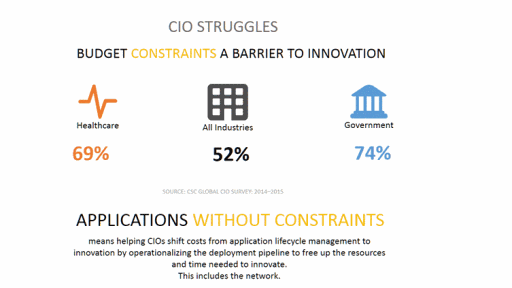제약 없는 응용 프로그램: IT 예산 최적화
연말이 되면 업계 간행물, 전문가, 분석가 등으로부터 전통적으로 예측과 전망이 잇따라 나옵니다. 여기에는 2016년 IT 예산에 대한 숫자가 가득한 예측도 포함되었습니다.
그중 어느 것도 특별히 인상적이지 않았습니다. IT 예산이 적어도 상승하는 조짐을 보이기 시작했다는 의견이 일치하지만, 많은 사람이 예산 제약을 장벽으로 보는 것도 여전히 사실이다.

우리는 이러한 진부한 말이 실제로 적용되는 것을 직접 보았습니다. 최근의 애플리케이션 제공 현황 설문 조사에 응답한 고객들은 보안 예산이 너무 적다는 것(41%)을 상위 5대 보안 과제 중 하나로 꼽았습니다. 최근 CSC 설문 조사에 따르면 CIO의 절반 이상은 예산 제약이 혁신에 대한 전반적인 장벽이라고 밝혔습니다.
물론, 혁신의 홍수문을 열고 IT가 단순히 사업을 지원하기 위해 돈을 소비하는 것이 아니라, 사업을 위해 돈을 버는 목표를 실현할 수 있도록 돕기 위해서는 이러한 제약을 완화해야 합니다.
하지만 옛 속담에도 말했듯이, 말하기는 쉽지만 실천하기는 어렵습니다.
이를 달성하기 위해 CIO는 운영, 보안, 앱 배포와 같은 예산의 핵심 영역을 최적화할 수 있는 환경(문화 수용)을 구축해야 합니다. 이러한 최적화를 통해 비용을 절감하여 절감된 비용을 혁신(수익 창출)에 집중한 프로젝트로 전환할 수도 있고, 지출을 늘릴 필요성을 완전히 없애 예산을 혁신에 집중할 수 있습니다.
궁극적으로 이는 모든 Dev(IT 사일로 삽입)Ops를 포함하는 DevOps를 도입하는 것을 의미합니다.
- 운영 최적화
DevOps와 관련된 캐치프레이즈 중 하나는 "코드로서의 인프라"입니다. 여기에는 조직의 60%가 앱의 빠르고 안전하며 가용성을 보장하기 위해 의존하는 평균 10개의 앱 서비스를 제공하는 네트워크 인프라가 포함될 수 있습니다. API와 템플릿을 활용하면 앱 서비스를 자동화하고 관리하여 비용을 절감하고 안정성을 향상시켜 비용이 많이 드는 다운타임을 줄일 수 있습니다. 그렇게 절감된 비용은 혁신에 투자될 수 있다. - 보안 최적화
보안은 클라우드와 온프레미스 전반의 주요 관심사입니다. 보안 예산은 증가하고 있지만, 점차 하이브리드 환경으로 변하는 거버넌스를 유지하기 위해 용감하게 노력하는 전문가들에게 이는 여전히 좌절의 원천입니다. 보안 통제, 정책 및 서비스가 점점 더 분리되면서 IT 부서가 비용을 증가시키지 않고도 긍정적인 보안 태세를 유지하는 능력이 저하되고 있습니다. 보안을 최적화하고 증가하는 보안 비용에 대처하는 한 가지 방법은 온프레미스와 클라우드에서 모두 사용할 수 있는 표준화된 정책 템플릿을 갖춘 공유 플랫폼을 통합하는 것입니다. 이를 통해 교육, 관리 및 서로 다른 환경에서 설계된 정책이 실제로 회사 정책을 준수하는지 확인하는 데 필요한 이중(또는 삼중) 검토와 관련된 비용이 줄어듭니다. - 앱 배포 최적화
마지막으로, 사용 가능한 많은 애플리케이션 중심 앱 서비스 의 이점 중 하나는 동일한 서비스를 설계, 구축하고 개발할 필요성을 완화할 수 있다는 것입니다. 확장성, 앱 보안, ID 관리, 심지어 성능 향상 서비스까지도 개발에서 운영으로(네트워크 인프라로) 전환하여 개발자는 개발에 집중하고 운영은 제공에 집중할 수 있습니다. 바퀴를 새로 만드는 일은 필요할 수 있지만 거의 필요하지 않습니다. 기존 플랫폼에서 제공되는 기존 서비스를 활용하면 운영 및 개발 비용을 모두 절감할 수 있으며, 절감된 비용은 다시 혁신에 투자할 수 있습니다.
혁신에 대한 예산 제약은 점점 더 큰 우려 사항이지만, 우리 모두는 지금 당장 예산을 최적화할 방법을 적극적으로 찾지 않는 한 일상적인 "전원 공급 유지" 비용이 낮아지지 않을 것이라는 사실을 알고 있습니다. Devops, 공유 플랫폼, 클라우드, 표준화는 CIO가 최적화를 통해 비용을 절감하고 혁신을 위한 더 큰 예산이라는 승리의 전리품을 누리기 위해 진지하게 노력할 때 귀중한 도구가 될 수 있습니다.
